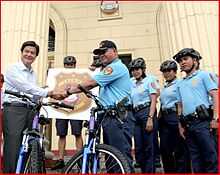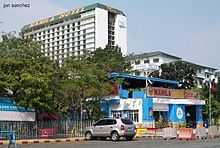Manila Police District
| Manila Police District | |
| Common name | Manila Police District |
| Abbreviation | MPD |
 | |
| Manila Police District patch depicting the department logo | |
| Motto | Manila's Finest |
| Agency overview | |
|---|---|
| Formed | January 9, 1901 |
| Preceding agencies |
|
| Legal personality | Governmental: Government agency |
| Jurisdictional structure | |
| Operations jurisdiction* | City of Manila in the region of Metro Manila, PHI |
| General nature |
|
| Operational structure | |
| Headquarters | Manila Police District Headquarters, United Nations Avenue, Manila |
| Agency executive | Rolando E Asuncion, Police Chief Superintendent (acting chief) |
| Parent agency | National Capital Region Police Office (NCRPO) |
| Website | |
| http://www.manila.gov.ph/manilapolice.htm | |
| Footnotes | |
| * Divisional agency: Division of the country, over which the agency has usual operational jurisdiction. | |
The Manila Police District (MPD) is the agency of the Philippine National Police (PNP) responsible for law enforcement in the City of Manila. Formerly known as the Western Police District (WPD), the MPD is under the National Capital Region Police Office (NCRPO), which also handles the Quezon City, Eastern, Northern and Southern Police Districts.
History
American period
The MPD was created as the Metropolitan Police Force of Manila by Act No. 70 of the Taft Commission. An entirely American body, the force was first stationed at the Goldenberg Mansion, San Miguel. Being provost marshal, Arthur MacArthur, Jr. was named first Manila police chief. WIth the enactment of Act No. 183 that established the Manila city charter on July 31, 1901, the force was reorganized and was headed by Capt. George Curry. The Metropolitan Police Force of Manila was renamed into the "Manila Police District," and was initially composed by 357 troops from the American Volunteer Force to the Philippines. The MPD has jurisdiction five miles from the city limits and three miles from the shores to Manila Bay. This led into disputes with the Philippine Constabulary, which had police powers elsewhere in the Philippines. In 1907, the MPD was split into two: the Meisic Police Station north of the Pasig River and the Luneta Police Station south of the river. By 1935, the headquarters was moved to the new Manila City Hall.[1]
On March 2, 1936, Antonio Torres, then a member of the Manila City Council, was appointed chief, the first Filipino do so. However, on 1942 at the outset of World War II, the Kempetai, the Japanese Military Police, ordered Torres to submit to their authority. After the Battle of Manila, the combined American and Filipino troops reorganized the police force, and Allied forces were appointed chiefs until the appointment of Lamberto Javalera as acting chief of police.[1]
Third Republic
In 1949, the MPD transferred their headquarters for the last time, in a newly constructed building at the corner of San Marcelino and Isaac Peral (now United Nations Avenue); the funding of the reconstruction came from the Philippine Rehabilitation Act of 1948. By this time, the President of the Philippines had appointment powers to the office. Notable was the appointment of Ricardo Papa, who organized an anti-smuggling unit that minimized smuggling in the city.[1]
Martial law to the present

On September 21, 1972, president Ferdinand Marcos declared martial law in the country and created the Integrated National Police, with the Philippine Constabulary as its nucleus. On December 20, 1974, James Barbers was appointed Superintendent (Police Chief) of the Western Police District (WPD). Metropolitan Police Force (MPF).[1] On February 26, 1986, Marcos was overthrown after the People Power Revolution. A few months later, Alfredo Lim was appointed chief and increased the number of precincts from six to ten. Lim would later be director of the National Bureau of Investigation, Mayor of Manila and Senator. In 1990, the Interior and Local Government Act 1990.was promulgated, that created the Philippine National Police, absorbing the Philippine Constabulary. Other notable names who had been named as WPD chief are Hermogenes Ebdane on November 5, 1993, and Avelino Razon on June 16, 1996 and December 20, 1999.[1] The two were later named chiefs of the PNP.
On July 20, 2005, the WPD reverted to their former name back to the Manila Police District.[1]
Organization
The MPD is organized into eleven (11) police stations and several district support units:[2][3]


Base Units
- Administrative Support Units
- District Tactical Operations Center
- District Headquarters Support Unit
- District Headquarters Service Unit
- District Human Resources and Administration Office
- District Internal Affairs Service
- District Legal Unit
- District Chaplain Service
- District Information Technology Unit
- District Scene Of the Crime Operatives
- Operations Support Units
- District Public Safety Battalion
- District Traffic Enforcement Group
- District Criminal Investigation and Detection Unit
- District Anti-Illegal Drugs - Special Operations Task Group
- District Public Information Office
- District Highway Patrol Group
- Criminal Investigation and Detection Group
Line Units
- MPD Station 1 (Balut Police Station) - Balut, Tondo
- MPD Station 2 (Moriones Police Station) - Moriones, Tondo
- MPD Station 3 (Sta Cruz Police Station) - Sta Cruz, Manila
- MPD Station 4 (Sampaloc Police Station) - Sampaloc, Manila
- MPD Station 5 (Ermita Police Station) - Ermita, Manila
- MPD Station 6 (Sta Ana Police Station) - Sta Ana, Manila
- MPD Station 7 (Abad Santos Police Station) - Jose Abad Santos, Manila
- MPD Station 8 (Sta Mesa Police Station) - Sta Mesa, Manila
- MPD Station 9 (Malate Police Station) - Malate, Manila
- MPD Station 10 (Pandacan Police Station) - Pandacan, Manila
- MPD Station 11 (MEISIC Police Station) - Meisic, Manila
Criticism
The PNP in general, and the MPD in particular, is characterized as slow, unfit, trigger-happy and corrupt. Several policemen have been arrested for committing extortion against violators of the law (popularly known as "kotong," hence the term "kotong cop").[4] Police are also involved in shootouts, or using excessive force against suspects.[5]
Recently two issues have been hurled against the MPD. One is the recent exposé of a policeman torturing a suspect in a police precinct in Tondo. The officer who allegedly tortured the suspect was filed with administrative chargers[6] Another was the inept resolution of the Manila hostage crisis which resulted in the death of 8 tourists from Hong Kong. MPD chief Rolando Magtibay was sacked two days after the failed assault.[7] His replacement, Senior Superintendent Francisco Villaroman, made acting head of the MPD, was replaced after one day. Police did not comment on his removal. However, the Philippine Daily Inquirer said Villaroman was among police officers charged in the disappearance of two Hong Kong residents in the Philippines in 1998 and 1999. Villaroman said that the matter was heavily politicized, as it was linked to the affairs of the then at-large Senator Panfilo Lacson.[8]
Lists of chiefs
- From establishment to Commonwealth
- January 9, 1901: Arthur MacArthur, Jr.
- July 31, 1901: George Curry
- About 1902: J.E. Harvin
- 1913: George Seaver
- June 16, 1918: Anton Hollman
- 1920: Edwin Bopp
- March 20, 1922: John William Green, III
- About March 2, 1929: Gregorio M. Alcid (acting)
- 1930: Columbus Piatt
- From Commonwealth to Western Police District
- March 2, 1936: Antonio Torres
- February 7, 1945: Marcus Ellis Jones
- June 1945: Jeremiah Holland
- March 1946: Angel Tuazon
- July 4, 1946: Lamberto Javalera
- 1947: Manuel dela Fuente
- 1948: Eduardo Quintos
- January 1, 1952: Dionisio Ojeda
- April 10, 1953: Cesar Lucero
- January 6, 1954: Telesforo Tenorio
- May 10, 1962: Marcos G Soliman
- September 17, 1962: Eduardo Quintos (second time)
- April 8, 1965: Eugenio Torres
- May 24, 1966: Ricardo Papa
- March 14, 1968: Enrique Morales
- November 30, 1968: Gerardo Tamayo
- As chief of the Western Police District
- December 20, 1974: James Barbers
- 1978: Pedro Dela Paz
- 1981: Narciso Cabrera
- October 3, 1986: Alfredo Lim
- December 22, 1989: Ernesto Diokno
- August 7, 1992: Oscar Aquino
- September 7, 1992. Proceso Almando
- December 8, 1992: Romeo O. Odi
- November 5, 1993: Hermogenes Ebdane
- June 16, 1996: Avelino Razon
- August 3, 1998: Virtus Gil
- December 16, 1998: Efren Fernandez
- December 20, 1999: Avelino Razon (second time)
- March 15, 2001: Nicolas Pasinos
- July 29, 2002: Pedro Bulaong
- As chief of the Manila Police District
- August 1, 2006: Danilo Abarzosa
- September 24, 2007: Roberto Rosales
- April 2, 2009: Rodolfo Magtibay
- August 25, 2010: Francisco Villaroman (OIC)
- August 27, 2010: Leocadio Santiago, Jr.
See also
- Philippine Constabulary
- Philippine National Police
- National Capital Region Police Office
- Quezon City Police District
- Northern Police District
- Eastern Police District
- Southern Police District
- Manila Fire District
References
- ↑ 1.0 1.1 1.2 1.3 1.4 1.5 "History of the Manila Police District". MPD official website. Retrieved 2010-08-27.
- ↑ http://police.contactnumbersph.com/tag/manila-police-district/
- ↑ http://ncrpo.pnp.gov.ph/index.php/key-officers/mpd
- ↑ "Manila Police chief cracks down on 'telebabad cops'". GMANews.tv. November 20, 2008. Retrieved 2010-08-28.
- ↑ "8 MPD members in April Delpan shootout charged with homicide". abs-cbnnews.com. May 6, 2008. Retrieved 2010-08-28.
- ↑ Tina Santos, Jeannette Andrade (August 20, 2010). "Cop in torture video faces raps". Philippine Daily Inquirer. Retrieved 2010-08-28.
- ↑ "Manila police OIC an expert in hostage situations". GMANews.tv. August 26, 2010. Retrieved 2010-08-28.
- ↑ Reuters, Agence France-Presse (Aug 28, 2010). "New chief lasts one day", South China Morning Post (Hong Kong)